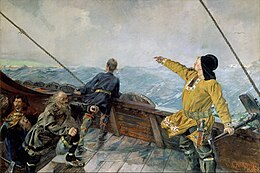
Back Кенсингтон руник ташы Bashkir Pedra de Kensington Catalan Kensingtonský kámen Czech Kensington-runestenen Danish Runenstein von Kensington German Kensingtonin riimukivi Finnish Pierre runique de Kensington French Pietra runica di Kensington Italian კენსინგტონის რუნული ქვა Georgian 켄싱턴 룬석 Korean
| Kensington Runestone | |
|---|---|
 The stone on display in the Alexandria Chamber of Commerce and Runestone Museum | |
| Created | 19th century |
| Discovered | 1898 CE Originally Kensington; currently located at Alexandria, Minnesota, United States |
| Discovered by | Olof Öhman |
| Runemaster | Disputed |
| Text – Native | |
| Swedish dialects 8 : göter : ok : 22 : norrmen : po : | |
| Translation | |
| (word-for-word): Eight Götalanders and 22 Northmen on (this?) exploration journey from Vinland far to the west. We had a camp by two (shelters?) one day's journey north from this stone. We were fishing one day. After we came home, found 10 men red from blood and dead. Ave Maria save from evil. (side of stone) There are 10 men by the inland sea to look after our ships fourteen days journey from this peninsula (or island). Year 1362 | |
| Part of a series on the |
| Norse colonization of North America |
|---|
 |


The Kensington Runestone is a slab of greywacke stone covered in runes that was discovered in central Minnesota, United States, in 1898. Olof Ohman, a Swedish immigrant, reported that he unearthed it from a field in the largely rural township of Solem in Douglas County. It was later named after the nearest settlement, Kensington.
The inscription purports to be a record left behind by Scandinavian explorers in the 14th century (internally dated to the year 1362). There has been a drawn-out debate regarding the stone's authenticity, but since the first scientific examination in 1910, the scholarly consensus has classified it as a 19th-century hoax, with some critics directly charging Ohman with fabrication.[1] Nevertheless, there remains a community convinced of the stone's authenticity.[2]
- ^ Gustavson, Helmer. "The non-enigmatic runes of the Kensington stone". Viking Heritage Magazine. 2004 (3). Gotland University.
[...] every Scandinavian runologist and expert in Scandinavian historical linguistics has declared the Kensington stone a hoax [...]
- Wallace, B (1971). "Some points of controversy". In Ashe G; et al. (eds.). The Quest for America. New York: Praeger. pp. 154–174. ISBN 0-269-02787-4.
- Wahlgren, Erik (1986). The Vikings and America (Ancient Peoples and Places). Thames & Hudson. ISBN 0-500-02109-0.
- Michlovic, MG (1990). "Folk Archaeology in Anthropological Perspective". Current Anthropology. 31 (11): 103–107. doi:10.1086/203813. S2CID 144500409.
- Hughey M, Michlovic MG (1989). "Making history: The Vikings in the American heartland". Politics, Culture and Society. 2 (3): 338–360. doi:10.1007/BF01384829. S2CID 145559328. - ^ Søderlind, Didrik (December 7, 2005). "Kan du stole på Wikipedia?". Forskning (in Norwegian). Archived from the original on October 7, 2007. Retrieved December 19, 2008.
Det finnes en liten klikk med amerikanere som sverger til at steinen er ekte. De er stort sett skandinaviskættede realister uten peiling på språk, og de har store skarer med tilhengere."
[There is a small clique of Americans who swear to the stone's authenticity. They are mainly natural scientists of Scandinavian descent with no knowledge of linguistics, and they have large numbers of adherents.]